Remove the air duct(A).
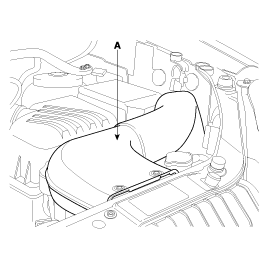
Use fender covers to avoid damaging painted surfaces.
To avoid damaging the cylinder head, wait until the engine coolant temperature drops below normal temperature before removing it.
When handling a metal gasket, take care not to fold the gasket or damage the contact surface of the gasket.
To avoid damage, unplug the wiring connectors carefully while holding the connector portion.
Mark all wiring and hoses to avoid misconnection.
Inspect the timing belt before removing the cylinder head.
Turn the crankshaft pulley so that the No. 1 piston is at top dead center. (See page EM - 13).
Remove the air duct(A).

Disconnect the negative terminal from the battery.

Drain the engine coolant. (See page EM - 77)
Remove the radiator cap to speed draining.
Remove the engine cover.
Remove the intake air hose and air cleaner assembly.
Disconnect the AFS connector(A).
Disconnect the breather hose(B) from air cleaner hose.
Remove the intake air hose and air cleaner assembly(C).

Remove the upper radiator hose(A) and lower radiator hose(B).
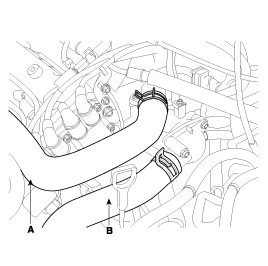
Remove the heater hoses(A).
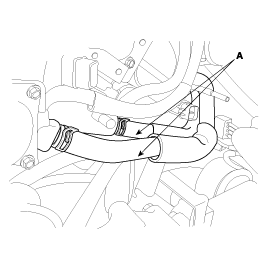
Remove the engine wire harness connectors and wire harness clamps from the cylinder head and the intake manifold.
TPS(Throttle Position Sensor) connector(A).
ISA(Idle Speed Actuator) connector(B).
PCSV(Purge Control Solenoid Valve) connector(C).
VIS actuator connector(D).
Injector connector(E).
Knock sensor connectors(F).
CMP(Camshaft Position Sensor) connector(G).
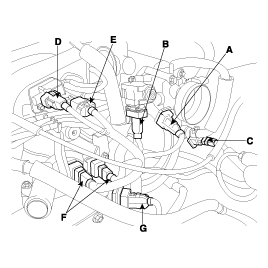
ECT(Engine Coolant Temperature) sensor connector(A).
Ignition coil connector(B).
Crankshaft position sensor connector(C).
Oxygen sensor connector(D).
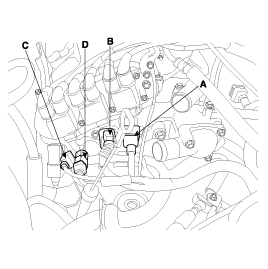
Three fuel injector connectors(A).
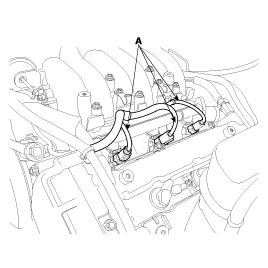
Disconnect ground cable(A) from the cowl panel.

IAT(Intake Air Temperature) sensor connector(A).
VIS actuator connector(B).
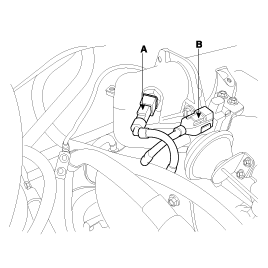
Remove the fuel inlet hose(A) from delivery pipe.
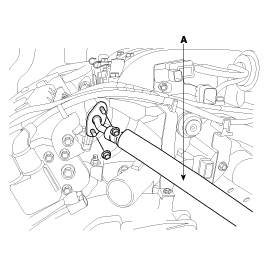
Remove the PCSV hose.
Remove the brake booster vacuum hose(A).

Remove the accelerator cable by loosening the locknut, then slip the cable end out of the throttle linkage.

Remove the PCV hose(A).
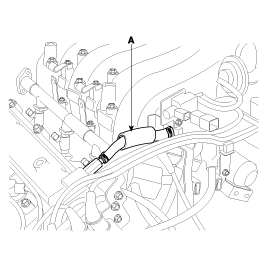
Remove the intake manifold. (See page EM - 93)
Remove the power steering pump. (See ST group - power steering pump).
Remove the exhaust manifold. (See page EM - 95)
Remove the timing belt. (See page EM - 13)
Remove the spark plug cable. (See EE group - ignition)
Remove the cylinder head covers(A).
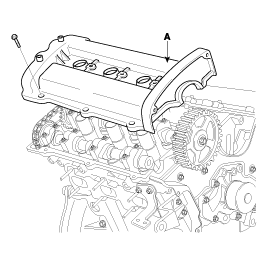
Remove the camshaft sprocket.
Remove the camshaft bearing caps(A).
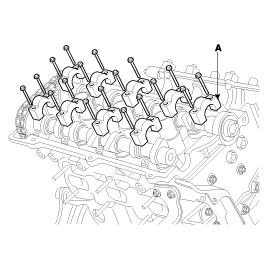

Remove the camshafts(A).
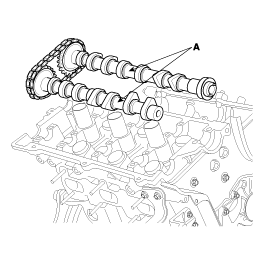
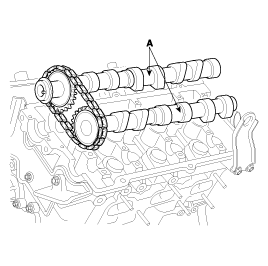
Remove the timing belt rear cover(A).
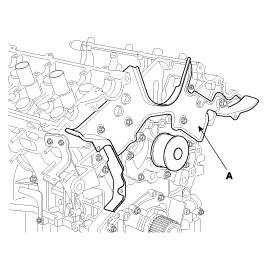
Remove the water temperature control assembly(A) and water pipe.
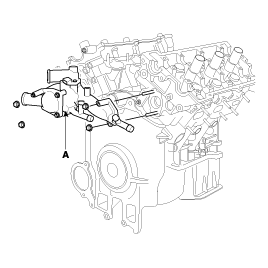
Remove the cylinder head bolts, then remove the cylinder heads.
Uniformly loosen and remove the 8 cylinder head bolts on each cylinder head in several passes and in the sequence shown, then repeat for the other side, as shown. Remove the 16 cylinder head bolts and plate washer.
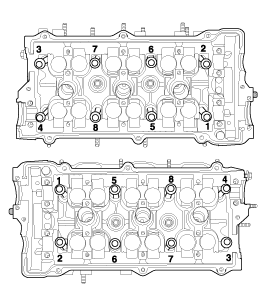
Head warpage or cracking could result from removing bolts in an incorrect order.
Lift the cylinder head from the dowels on the cylinder block and place the cylinder head on wooden blocks on a bench.
Be careful not to damage the contact surfaces of the cylinder head and cylinder block.
Using the SST(09221-3F100A), withdraw the old valve guide toward the bottom of cylinder head.
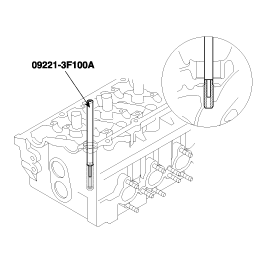
Recondition the valve guide hole so that it can match the newly press-fitted oversize valve guide.
Using the SST(09221-3F100A/B), press-fit the valve guide. The valve guide must be press-fitted from the upper side of the cylinder head. Keep in mind that the intake and exhaust valve guides are different in length.
Over size mm(in.) | Size mark | Oversize valve guide hole size mm(in.) |
0.05 (0.002) | 5 | 11.05 ~ 11.068 (0.4350 ~ 0.4357) |
0.25 (0.010) | 25 | 11.25 ~ 11.268 (0.4429 ~ 0.4436) |
0.50 (0.020) | 50 | 11.50 ~ 11.518 (0.4528 ~ 0.4535) |
Valve guide length
Intake : 39mm (1.535in.)
Exhaust : 43mm (1.693in.)
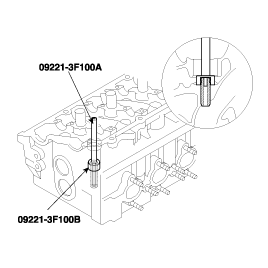
After the valve guide is press-fitted, insert a new valve and check for proper stem -to-guide clearance.
After the valve guide is replaced, check that the valve is seated properly. Recondition the valve seats as necessary.
Thoroughly clean all parts to be assembled.
Always use a new head and manifold gasket.
The cylinder head gasket is a metal gasket. Take care not to bend it.
Rotate the crankshaft, set the No.1 piston at TDC. (See page EM - 13).
Install the cylinder head gaskets on the cylinder block.
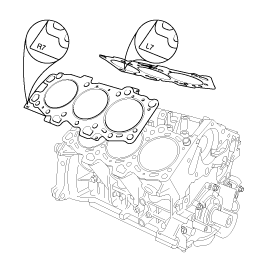
Be careful of the installation direction.
Place the cylinder head quietly in order not to damage the gasket with the bottom part of the end.
Install cylinder head bolts.
Tightening torque
25Nm (250kgf.cm, 18lbf.ft) + 60° + 45°
Apply a light coat if engine oil on the threads and under the heads of the cylinder head bolts.
Install the plate washer to the cylinder head bolt.
Install the uniformly tighten the cylinder head bolts on each cylinder head in servral passes and in the sequence shown, then repeat for the other side, as shown.

If only of the cylinder head bolts dose not meet the torque specification, repeat the cylinder head bolt.
Torque : 25Nm (250kgf.cm, 18lbf.ft)

Retighten the cylinder head bolts by 60° in the numerical order shown.
Retighten the cylinder head bolts by 45° in the numerical order shown.
Install the water pipe and water temperature control assembly(A).
Tightening torque
Water temperature control
15 ~ 20Nm (150 ~ 200kgf.cm, 11 ~ 14lbf.ft)

Install the timing belt rear cover(A).
Tightening torque
Timing belt rear cover
10 ~ 12Nm (100 ~ 120kgf.cm, 7 ~ 9lbf.ft)

Install the camshafts.
Align the camshaft timing chain with the intake timing chain sprocket and exhaust timing chain sprocket as shown.
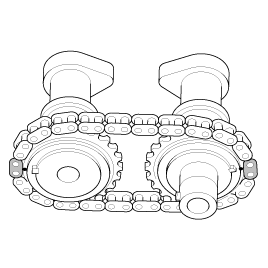
Install the camshaft(A).

Install the camshaft bearing caps(A).
Tightening torque
10 ~ 12Nm (100 ~ 120kgf.cm, 7 ~ 9lbf.ft)
14 ~ 16Nm (140 ~ 160kgf.cm, 10 ~ 12lbf.ft)

Apply new engine oil to the thrust portion and journal of the camshafts.
Apply a light coat of engine oil on the threads and under the heads of the bearing cap bolts.
Using the SST (09214-21000), install the camshaft bearing oil seal.
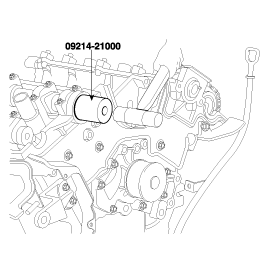
Install the camshaft sprocket.
Temporarily install the camshaft sprocket bolts.
Hold the hexagonal head wrench portion of the camshaft with a wrench, and tighten the camshaft sprocket bolts.
Tightening torque
Camshaft sprocket bolt
90 ~ 110Nm (900 ~ 1100kgf.cm, 65 ~80lbf.ft)
Install semi-circular packing.
Install the cylinder head cover.
Install the cylinder head cover gasket(A) in the groove of the cylinder head cover(B).
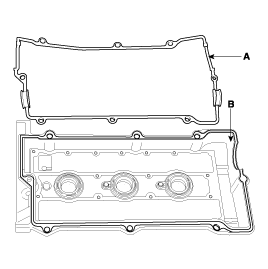
Before installing the head cover gasket, thoroughly clean the head cover gasket and the groove.
When installing, make sure the head cover gasket is seated securely in the corners of the recesses with no gap.
Apply liquid gasket to the head cover gasket at the corners of the recess.
Use liquid gasket, loctite No.5699.
Check that the mating surfaces are clean and dry before applying liquid gasket.
After assembly, wait at least 30 minutes before filling the engine with oil.
Install the cylinder head covers(A) with the 16bolts. Uniformly tighten the bolts in several passes.
Tightening torque
8 ~ 10Nm (80 ~ 100kgf.cm, 6 ~ 7.4lbf.ft)


Install the spark plug cable. (See EE group - ignition)
Install the timing belt. (See page EM - 17).
Install the exhaust manifold. (See page EM - 98)
Install the power steering pump. (See ST group - power steering pump)
Install the intake manifold. (See page EM- 97)
Install the PCV hose(A).

Install the accelerator cable.

Install the brake booster vacuum hose(A).

Install the PCSV hose.
Install the fuel inlet hose(A).

Install the engine wire harness connectors and wire harness clamps to the cylinder head and the intake manifold.
VIS actuator connector(B).
IAT(Intake Air Temperature) sensor connector(A).

Connect the ground cable(A) to the cowl panel.

Three fuel injector connectors(A).

Oxygen sensor connector(D).
Crankshaft position sensor connector(C).
Ignition coil connector(B).
ECT sensor connector(A).

CMP(Camshaft position sensor) connector(G).
Knock sensor connector(F).
Injector connector(E).
VIS actuator connector(D).
PCSV(Purge Control Solenoid Valve) connector(C).
ISA connector(B).
TPS connector(A).

Install the heater hoses(A).

Install the upper radiator hose(A) and lower radiator hose(B).

Install the intake air hose and air cleaner assembly.
Install the intake air hose and air cleaner assembly(C).
Connect the breather hose(B) from air cleaner hose.
Connect the AFS connector(A).

Install the engine cover.
Connect the negative terminal to the battery.

Install the air duct(A).

Filll with engine coolant.
Start the engine and check for leaks.
Recheck engine coolant level and oil level.
Identify HLA(Hydraulic Lash Adjuster), valves, valve springs as they are removed so that each item can be reinstalled in its original position.
Remove HLAs(A).
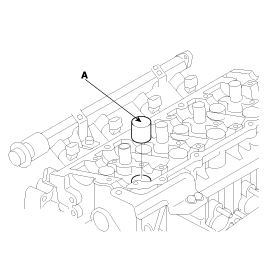
Remove valves.
Using SST(09222-28000, 09222-28100), compress the valve spring and remove retainer lock.
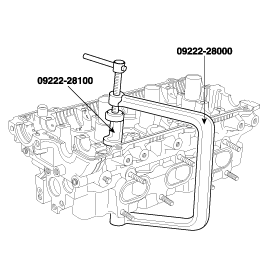
Remove the spring retainer.
Remove the valve spring.
Remove the valve.
Using needle-nose pliers, remove the oil seal.
Using a magnetic finger, remove the spring seat.
Clean top surfaces of pistons and cylinder block.
Turn the crankshaft, and bring each piston to top dead center(TDC).
Using a gasket scraper, remove all the carbon from the piston top surface.
Using a gasket scraper, remove all the gasket material from the cylinder block surface.
Using compressed air, blow carbon and oil from the bolt holes.
Remove gasket material.
Using a gsket scraper, remove all the gasket material from the cylinder block contact surface.
Be careful not to scratch the cylinder block contact surface.
Clean combustion cambers.
Using a wire brush, remove all the carbon from the combustion cambers.
Be careful not to scratch the cylinder block contact surface.
Clean cylinder heads.
Using a soft brush and solvent. throrghly clean the cylinder head.
Clean valves.
Using a gasket scraper, chip off any carbon from the valve head.
Using a wire brush throroghly clean the valve.
Inspect for flatness.
Using a precision straight edge and feeler gauge, measure the surface the contacting the cylinder block for warpage.
Flatness of cylinder head gasket surface
Standard : Less than 0.03mm(0.0012 in.)
Limit : 0.06 mm ( 0.0024 in.)
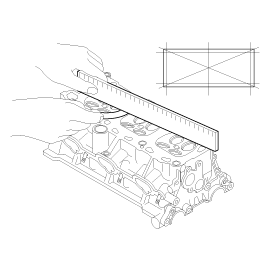
Inspect for cracks.
Check the combustion chamber, intake ports, exhaust ports and cylinder block surface for cracks. If cracked, replace the cylinder head.
Inspect valve stems and valve guides.
Using a caliper gauge, measure the inside diameter or the valve guide.
Valve guide inside.

Using a micrometer, measure the diameter of the valve stem.

Subtract the valve stem diameter measurement from the valve guide inside diameter measurement.
Valve stem-to-guide clearance
[Standard]
Intake : 0.02 ~ 0.05mm (0.0008 ~ 0.0020in.)
Exhaust : 0.030 ~ 0.065mm (0.0012 ~ 0.0026in.)
[Limit]
Intake : 0.1mm (0.0040in.)
Exhaust : 0.13mm (0.0051in.)
If the clearance is greater than maximum, replace the valve and valve guide.
Inspect valves.
Check the valve is ground to the correct valve face angle.
Check that the surface of the valve for wear.
If the valve face is worn, replace the valve.
Check the valve head margin thickness.
If the margin thickness is less than minimum, replace the valve.
Margin
[Standard]
Intake : 1.0mm (0.0394in.)
Exhaust : 1.3mm (0.0512in.)
[Limit]
Intake : 0.5mm (0.0197in.)
Exhaust : 0.8mm (0.0315in.)
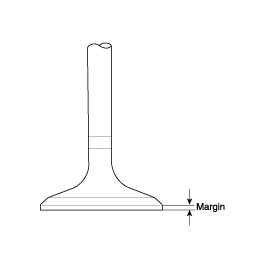
Check the surface of the valve stem tip for wear.
If the valve stem tip is worn, replace the valve.
Inspect valve seats
Check the valve seat for evidence of overheating and improper contact with the valve face.
Replace the seat if necessary.
Before reconditioning the seat, check the valve guide for wear. If the valve guide is worn, replace it, then recondition the seat. Recondition the valve seat with a valve seat grinder or cutter. The valve seat contact width should be within specifications and centered on the valve face.
Inspect valve springs.
Using a steel square, measure the out-of-square of the valve spring.
Using a vernier calipers, measure the free length of the valve spring.
Valve spring
[Standard]
Free height : 42.5mm (1.6732in.)
Load : 21kg/35mm (48.4kg/1.378mm)
[Limit]
Free height : -1.0mm ( -0.0394 in.)
Out-of-square : 3°
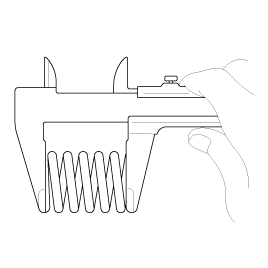
If the free length is not as specified, replace the valve spring.
Inspect cam lobes.
Using a micrometer, measure the cam lobe height.
Cam height
[Standard value]
Intake : 43.95 ~44.15mm (1.7303 ~ 1.7382in.)
Exhaust : 43.95 ~ 44.15mm (1.7303 ~ 1.7382in.)

If the cam lobe height is less than minimum, replace the camshaft.
Inspect cam journals.
Using a micrometer, measure the journal diameter.
Journal diameter
Standard value
25.964 ~ 25.980mm (1.0222 ~ 1.0228in.)
If the journal diameter is not as specified, check the oil clearance.
Inspect camshaft bearings.
Check that bearing for flaking and scoring. If the bearings are damaged, replace the bearing caps and cylinder head as a set.
Inspect camshaft journal oil clearance.
Clean the bearing caps and camshaft journals.
Place the camshafts on the cylinder head.
Lay a strip of plastigage across each of the camshaft journal.
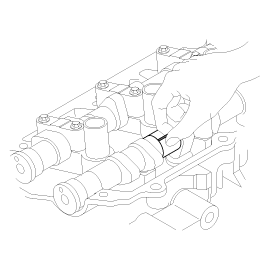
Install the bearing caps. (See page EM - 38)
Do not turn the camshaft.
Remove the bearing caps.
Measure the plastigage at its widest point.
Bearing oil clearance
Standard value : 0.02 ~ 0.061mm (0.0008 ~ 0.0024in.)
Limit : 0.1mm (0.0039in.)
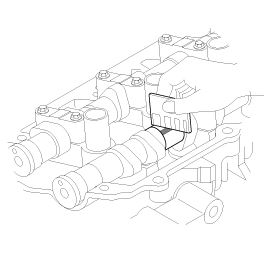
If the oil clearance is greater than maximum, replace the camshaft. If necessary, replace the bearing caps and cylinder head as a set.
Completely remove the plastigage.
Remove the camshafts.
Inspect camshaft end play.
Install the camshafts. (See page EM - 38).
Using a dial indicator, measure the end play while moving the camshaft back and forth.
Camshaft end play
Standard value : 0.1 ~ 0.15mm (0.004 ~ 0.0059in.)
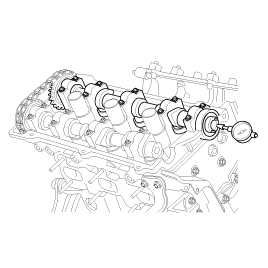
If the end play is greater than maximum, replace the camshaft. If necessary, replace the bearing caps and cylinder head as a set.
Remove the camshafts.
Thoroughly clean all parts to be assembled.
Before installing the parts, apply fresh engine oil to all sliding and rotating surfaces.
Replace oil seals with new ones.
Install valves.
Install the spring seats.
Using SST(09222-22001), push in a new oil seal.
Do not reuse old valve stem seals.
Incorrect installation of the seal could result in oil leakage past the valve guides.
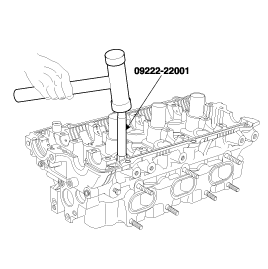
Install the valve, valve spring and spring retainer.
Place valve springs so that the side coated with enamel faces toward the valve spring retainer and then installs the retainer.
Using the SST(09222-28000, 09222-28100), compress the spring and install the retainer locks. After installing the valves, ensure that the retainer locks are correctly in place before releasing the valve spring compressor.

Lightly tap the end of each valve stem two or three times with the wooden handle of a hammer to ensure proper seating of the valve and retainer lock.

Install HLAs.
Check that the HLA rotates smoothly by hand.
